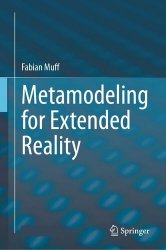 Название: Metamodeling for Extended Reality Название: Metamodeling for Extended Reality
Автор: Fabian Muff
Издательство: Springer
Год: 2025
Страниц: 264
Язык: английский
Формат: pdf (true), epub
Размер: 50.4 MB
This book which is based on the author’s dissertation in 2024 explores the challenges of metamodeling in the context of extended reality and emphasizes the need for new concepts in metamodeling to effectively combine it with extended reality technologies. The central question of this work is how metamodeling can be used “in” and “for” extended reality.
Augmented reality, virtual reality, and mixed reality, commonly referred to as extended reality, are technologies that have gained importance in research and industry in recent years. However, they are not new concepts. As early as the mid-1960s, Sutherland attempted to define virtual reality as a window through which a user can perceive an artificial, virtual world as if it were a real environment that looks, feels, and sounds like the real world. At that time, three-dimensional (3D) applications required substantial computing power. Thus, high-end supercomputers were needed. In addition, the development of these applications was complicated due to the low-level software platforms available at the time. Technological progress in recent years has led to the widespread availability of affordable and mobile XR devices that allowed for the broad application of the technology, e.g., for gaming, navigation, military use, maintenance tasks, or training.
A well-known method for generalizing concepts in the discipline of conceptual modeling is metamodeling. With metamodeling, one can create computer models in predefined conceptual modeling languages such as BPMN, UML or approaches for design thinking, simulation and many more. By providing a platform that defines the concepts and mechanisms for all underlying metamodels, i.e., models of modeling languages, the synergies and common concepts can be defined once and used in common. Furthermore, by using metamodeling and the underlying concepts, different modeling languages can be interconnected and used together, which would not be possible in specific modeling environments. Thus, data between models can be exchanged, and models can be processed. In addition, by providing a general approach, the adaptation and creation of modeling languages is much faster and more productive than without such an approach.
The book is structured in nine chapters: Chapter 1 introduces the topic by providing background information and outlining the research objectives, questions, methodology and structure. Chapter 2 delves into the existing literature and developments in the field. It covers various aspects of modeling, such as conceptual, enterprise, and metamodeling, as well as extended reality (XR), virtual reality (VR), augmented reality (AR), and the metaverse. Next, chapter 3 presents the generic requirements for metamodeling for augmented and virtual reality by systematically deriving use cases for joining AR and metamodeling. Chapter 4 then identifies specific requirements for integrating metamodeling with XR, such as coordinate mappings, visualization of model components, detection and tracking, context, or interaction. Subsequently, chapter 5 introduces a new domain-specific visual modeling language for creating augmented reality scenarios, particularly within the context of metamodeling, before chapter 6 outlines the conceptualization and design of a 3D enhanced metamodeling platform considering extended reality, detailing its structure, components, and the interconnection of its elements. Chapter 7 then presents the initial implementation of the various components of this modeling platform, and chapter 8 evaluates the newly introduced platform both theoretically and empirically. Eventually, chapter 9 concludes the book by an alignment with the initial research questions, discussing limitations, and provides a final summary and an outlook for further research.
This book mainly aims at researchers in conceptual modeling, especially in projects related to XR, VR, or AR, as the presented new domain-specific modeling method for creating workflows for XR/VR/AR applications does not assume specific prior programming knowledge.
Contents:
1. Introduction
2. State-of-the-Art and Related Work
3. Derivation of Generic Requirements for Metamodeling for Extended Reality
4. Specific Requirements for Metamodeling for Extended Reality
5. ARWFMM: A Modeling Method as an Example for Knowledge-Based Virtual and Augmented Reality
6. M2AR: An Architecture for a 3D Enhanced Metamodeling Platform for Extended Reality
7. Prototypical Realization of the M2AR Metamodeling Platform
8. Evaluation of the M2AR Platform Prototype
9. Summary and Outlook
Скачать Metamodeling for Extended Reality
|